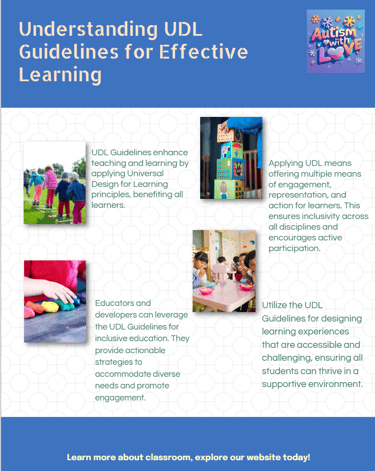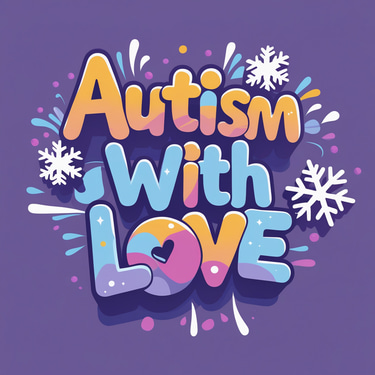Understanding UDL Guidelines: A Framework for Inclusive Learning
Introduction to UDL Guidelines - Universal Design for Learning (UDL) is an educational framework that provides a foundation for creating inclusive learning environments. Its core principle is to accommodate the diverse needs of all learners by promoting flexibility in the ways information is presented, how students engage with the content, and how they demonstrate their understanding. The UDL guidelines serve as a structured approach to implementing teaching strategies that are informed by scientific research on learning processes.
AUSTISM SUPPORT
W.Love
4/28/20257 min read


Let's talk about inclusion in education. It has gained significant momentum in recent years especially for those in special educaiton environments, as educators strive to recognize and address the varying abilities and backgrounds of students. UDL plays a pivotal role in this movement, offering a set of guidelines that aim to improve teaching and learning for everyone. By focusing on multiple means of engagement, representation, and action and expression, educators can craft lessons that not only accommodate but also celebrate diversity within the classroom.
The significance of UDL in the modern educational landscape cannot be understated, as you know ASD is a spectrum and no students are alike. As classrooms become increasingly diverse, traditional one-size-fits-all teaching methods fall short in effectively reaching all learners. UDL emphasizes sustainable strategies that align with individual learning differences and encourages educators to adapt their practices in response to changing needs. This adaptability is essential for fostering an environment where all students can thrive.
Furthermore, UDL underscores the importance of removing barriers to learning, allowing all students to access the same educational opportunities. By embracing UDL guidelines, educators can cultivate a culture of inclusivity that not only acknowledges individual differences but also enhances overall educational outcomes. Ultimately, UDL is not merely a set of recommendations; it is a vital approach to fostering equitable learning experiences that resonate with the diverse tapestry of today’s learners.
Principles of UDL
The Universal Design for Learning (UDL) framework is anchored in three primary principles that are essential for fostering an inclusive learning environment. The first principle, multiple means of engagement, emphasizes the importance of motivation in the learning process. This principle recognizes that students have varied interests and preferences, necessitating diverse strategies to engage them effectively. By offering different avenues for participation, such as project-based learning, technology integration, and collaborative activities, educators can ensure that all learners find pathways to stay motivated and involved.
The second principle, multiple means of representation, focuses on how information is presented to learners. Individuals process and comprehend information differently, influenced by factors such as cultural background, cognitive abilities, and learning preferences. This principle advocates for providing content in various formats, including text, audio, video, and interactive media. Doing so accommodates different learning styles and promotes better understanding of the material. When students receive information through different modalities, they are more likely to grasp complex concepts and retain knowledge effectively.
The third principle of UDL concerns multiple means of action and expression. This principle highlights the significance of allowing students to demonstrate their understanding in various ways. Just as learners vary in their engagement and representation of content, they also differ in how they express what they have learned. By offering choices such as written assignments, presentations, or creative projects, educators can accommodate diverse capabilities and preferences. This flexibility ensures that all students can showcase their knowledge and skills, ultimately fostering a sense of confidence and success in their learning journeys.
The Importance of UDL Guidelines in Education
The Universal Design for Learning (UDL) guidelines are an essential framework that promotes inclusivity within educational settings. By focusing on flexibility and personalization, these guidelines ensure that all students, regardless of their individual learning needs, have equal opportunities to succeed. One of the primary benefits of implementing UDL guidelines is the enhanced accessibility they provide. Accessibility is crucial to creating a learning environment where every student can engage and participate fully, regardless of their abilities or background.
Furthermore, UDL guidelines aim to improve learner engagement by incorporating various teaching methods and materials tailored to different learning profiles. This approach encourages educators to adopt diverse instructional strategies, which can lead to a more stimulating and interactive classroom atmosphere. When students are presented with multiple means of engagement, representation, and action, they are more likely to feel motivated and connected to the learning process. As a result, UDL guidelines contribute to higher levels of participation and interest in academic activities.
Another significant advantage of UDL is the enhancement of the overall learning experience for all students. By recognizing that learners come with a variety of strengths, weaknesses, and preferences, UDL provides a roadmap for educators to create an inclusive curriculum. This framework not only assists students with disabilities but also benefits those with diverse learning preferences by offering various ways to access information, demonstrate knowledge, and participate in the learning community. This customization fosters a positive environment where students feel valued and empowered in their educational journey.
In conclusion, the importance of UDL guidelines in education cannot be overstated. By promoting accessibility, improving learner engagement, and enhancing the overall learning experience, UDL serves as a vital tool in fostering inclusive and effective educational practices.
Applying UDL Guidelines in the Classroom
Implementing Universal Design for Learning (UDL) guidelines in the classroom involves strategic adjustments to lesson plans, utilizing technology, and designing assessments that reflect diverse learning needs. These guidelines encourage educators to create an environment that fosters engagement, representation, and action for all students. By adapting lesson plans, teachers can cater to various learning preferences and challenges, ensuring inclusivity in their approach.
One practical strategy includes offering multiple means of engagement. This could involve presenting information through varied formats such as video, audio, or hands-on experiences. For instance, when introducing a new topic, educators can provide a video that outlines essential concepts, followed by a hands-on activity that allows students to explore the material practically. This approach addresses different learning styles—visual, auditory, and kinesthetic—engaging a wider range of learners.
Incorporating technology is another crucial aspect of applying UDL principles. Educational tools and software designed for diverse learners can significantly enhance the learning experience. For instance, interactive applications can provide instant feedback, allowing students to work at their own pace and according to their comprehension levels. Similarly, assistive technologies, such as text-to-speech programs or speech-to-text applications, can empower students with disabilities by removing barriers to access.
When it comes to assessments, utilizing flexible methods to gauge student understanding is vital. Rather than relying solely on traditional testing formats, educators might consider portfolios, presentations, or group projects. These alternatives not only accommodate various skills and strengths but also promote collaborative learning environments. By integrating UDL guidelines thoughtfully, teachers can create a dynamic classroom culture that values diversity and fosters successful learning outcomes for all students.
UDL Guidelines for Curriculum Developers
The Universal Design for Learning (UDL) framework serves as a powerful tool for curriculum developers aiming to create inclusive learning environments. By integrating UDL guidelines, curriculum developers can ensure that their educational materials and experiences are accessible to all students, regardless of their diverse learning needs, preferences, and backgrounds. The essential principle behind UDL is to provide multiple means of engagement, representation, and action and expression, which allow learners to pursue knowledge in ways that best suit their individual strengths.
To effectively implement UDL guidelines, curriculum developers should begin by thoroughly analyzing the needs of their learner population. This involves gathering information about students' varying abilities, interests, and motivations. By understanding these differences, developers can design curriculum frameworks that are flexible and adaptable, offering multiple pathways for learners to achieve their educational goals. Such flexibility could include providing choices in assessment methods, instructional materials, and formats that cater to varied learning styles.
Additionally, incorporating technology can enhance the implementation of UDL principles. Digital tools and resources can facilitate differentiated learning experiences, allowing for real-time adjustments and feedback tailored to individual learners. For instance, using multimedia elements not only engages students but also aids in conveying complex information in various formats, making it easier for all students to access crucial content.
Ultimately, the integration of UDL guidelines into curriculum development is not merely a theoretical exercise; it is a commitment to fostering an inclusive educational landscape. By emphasizing universal design, curriculum developers cultivate learning experiences that resonate with a broad spectrum of learners, thus enhancing educational outcomes. This ensures that all students are afforded equal opportunities to succeed, contributing to a more equitable and just academic environment.
UDL Guidelines Beyond the Classroom
Universal Design for Learning (UDL) guidelines extend their influence beyond the traditional classroom environment, showcasing their versatility and adaptability in various educational contexts. The principles behind UDL promote flexibility in teaching methods, thereby accommodating a diverse range of learners. For instance, in online education, UDL guidelines facilitate the creation of personalized learning experiences. Virtual environments allow for the modification of course materials through multimedia presentations, enabling learners to engage with content in multiple ways, whether through videos, interactive simulations, or text-based resources. This adaptability enhances accessibility, ensuring that learners with different needs can navigate and benefit from the course material effectively.
Beyond online platforms, UDL principles are increasingly applied in corporate training programs. Companies are recognizing the importance of engaging a diverse workforce by implementing UDL strategies in employee development initiatives. By providing varied instructional methods—like mentoring, hands-on experiences, and self-directed learning—businesses empower employees to choose the learning modes that best suit their individual styles and preferences. This inclusive approach not only promotes equity within the workforce but also enhances overall job satisfaction and productivity.
Moreover, UDL guidelines significantly inform the development of educational resources tailored for parents and communities. Workshops, informational sessions, and guidance materials that incorporate UDL principles equip families with the tools necessary to support their children's learning at home. This community building fosters a shared understanding of inclusive practices, creating an environment where every learner is valued and can thrive. Thus, UDL guidelines serve as an invaluable framework that transcends classroom walls, establishing an inclusive approach to education across various spheres of life.
As educational landscapes continue to evolve, the UDL guidelines remain a critical component in shaping effective instructional practices. The adaptability of UDL principles allows for their application across different contexts, including remote learning, hybrid models, and traditional classroom settings. This ongoing evolution underscores the importance of educators being well-versed in UDL frameworks, so that they can effectively respond to the changing dynamics of teaching and learning.
Moreover, the future of UDL is marked by an increasing emphasis on inclusive practices that not only recognize but also celebrate diversity in learning. As educational institutions strive to create environments that cater to all learners, adherence to UDL principles will be paramount. Collaborative efforts among educators, administrators, and policymakers are essential for integrating UDL into curriculum design and teaching methodologies, thus fostering a culture of inclusivity.


